Welcome! VineOnline is a blog dedicated to reporting the latest news and events from ChinaVine team members
|
On July 9 the UO field work team in Beijing did intensive field work today in Jianguo – food, Red tourism, rose tea, and a hike up Miaofeng mountain to the Three Temples. Lunch provided a way to experience Jianguo’s goal to be tourist destination for experiencing local meals made from local products, both wild and cultivated. Lunch was hosted by Mr. Wong at the Host Household for Folklore Tours.
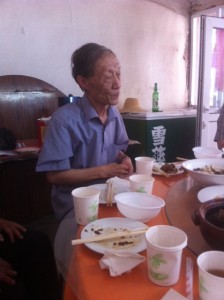
Following is what we were served.
We ate and drank from very simple paper cups, bowls, china plates, using the most rudimentary chopsticks.
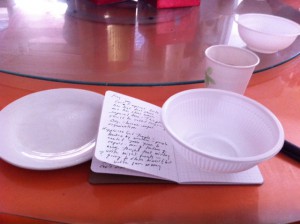
Tea, beer, tomatoes with sugar, salted peanuts, elbow of pig, chicken, pork rib, tofu with moutain mushrooms, wild greens, fried river shrimp, a fish from the Yongding River,
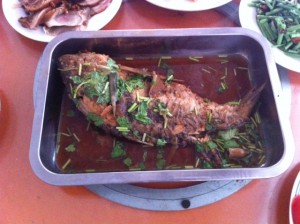
rose pancake, egg pancake, fried roses (new recipe) and fried tree leaf (xiang chun tree),
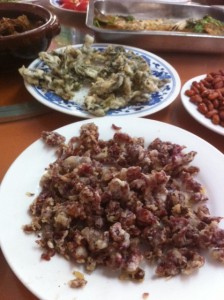 e e
deer, fried flour (called gezhi after the sound it makes, and a wild vegetable filled pancake (referred to as revival food).
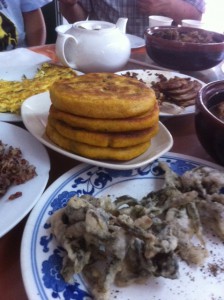
While we ate Mr. Wong talked to us about wine (1 glass sweet, 2 confident talk, 3 babble, 4 under the table), a drinking game involving ten descriptors, and chop sticks.
How can ChinaVine reach new audiences in academic environments? Previous iterations of the Vine Online blog have been used in classrooms to promote thought-provoking online discussions of educational value. By publishing intriguing posts related to Chinese art and culture, students and teachers are able to create new dialogue and opinions about the content while learning about different peoples of the world. Emily Hope Dobkin is currently a first-year Master’s candidate in the Arts Administration program at the University of Oregon collaborating with the Jordan Schnitzer Museum of Art (JSMA) to create a firm grounding for ChinaVine’s educational content to be utilized in new academic and museological settings. During this Spring 2011 term, Dobkin works specifically in the JSMA’s Education Department to integrate elements of ChinaVine into their Chinese Art and Culture Outreach kit.
Known as a teaching museum, the JSMA has a lofty vision: to become one of the finest university art museums in the world. The JSMA is located on the University of Oregon campus, and works closely with the university to accomplish their mission. The museum’s website states their mission “enhances the University of Oregon’s academic mission and furthers the appreciation and enjoyment of the visual arts for the general public.” This goal is being accomplished in part by the JSMA’s emphasis on teaching Asian Arts, and particularly through extended materials such as the China Art and Culture Outreach program.
The Chinese Art and Culture program consists of an actual physical kit and teacher resource guide. The primary goal of the Chinese Art and Culture Outreach program is to provide local educators with resources representative of the Chinese collection. These resources help integrate the arts into the general curriculum while fostering the mission and education philosophy of the JSMA. The museum provides books, maps, and projection materials for their learning kits, as well as various examples from the museum itself. Now, in addition, the museum is incorporating ChinaVine’s content as part of its curriculum.
ChinaVine’s mission is to educate English-speaking/reading children, youth, and adults about China’s cultural heritage. This mission is achieved through this interactive website along with a variety of social media platforms. “Vine” is combined with China because of the fluid, ever changing and winding ways of culture. This mission, combined with JSMA’s Chinese Art & Culture Outreach program, allows for a fluid teaching methodology as well.
Dobkin’s work with JSMA revisits the current outreach kit with new resource materials including content from ChinaVine. The ultimate goal will be to upload the revised teacher resource guide to the JSMA and ChinaVine websites, and for educators to actively utilize these materials in their classrooms.
In present-day China, many young Chinese people are moving to urban areas to further their education and careers. Through this migration, many Chinese folk traditions are no longer being practiced. Dobkin is effectively collaborating with the JSMA to celebrate, document, and preserve China’s national identity and history by stressing the importance of cultural preservation. In doing so, both the mission of the Jordan Schnitzer Museum of Art and ChinaVine is achieved.
The JSMA is proactively creating education programs that go beyond the walls of museums to reach diverse audiences. The ChinaVine project shares this activity by utilizing digital resources as emerging technologies for learning, such as video streaming. For example, Dobkin has enhanced the first Unit that focuses on Chinese Festivals and Celebrations by including streaming video. Regarding this content, she states, “Under the New Year category, I suggested looking at the New Years paintings and short video from Gaomi:” [vimeo]http://vimeo.com/4215434[/vimeo]
Another example Dobkin includes in the Chinese Festivals and Celebrations Unit is a newly revised kite-making activity relating to the Qing Ming festival. Dobkin writes, “I emphasized that besides picnicking, hiking and tree planting, kite flying is also enjoyed during the Spring Festival, and further directed teachers to information on kite making in Weifang and Beijing from the ChinaVine website.” Among the suggested learning material on this topic, Dobkin recommends the following segment on the Beijing-style of kite-craft: [vimeo]http://vimeo.com/4401305[/vimeo]
Following this first unit, subsequent lessons will teach about traditional Chinese costumes, painting, calligraphy, paper cuts, and dough figures. Dobkin believes “this term is just the beginning of integrating ChinaVine into resource guides for teachers and educators. The JSMA’S guide still has room for even more ChinaVine projects to be infused, and I am excited to see what this summer’s field school brings back that can be further integrated into the JSMA’s Chinese Art and Culture Outreach kit.”
On June 1st, educations across the state of Oregon were invited to the JSMA for “Arts Education Night,” in which Dobkin shared the newly revised outreach kit with local teachers.
“Even though this academic school year is coming to an end, it was a great opportunity for teachers to start thinking about refreshing their lessons for next fall. Every single teacher I interacted with was quite enthused and eager to learn more about ChinaVine; especially creative ways they could share it with their students,” explains Dobkin.
As always, keep your browser directed at Vine Online for continued updates on ChinaVine.
 Mary-Kate Murphy Chinese cuisine, calligraphy, mask changing performances, and tea ceremonies; these are just some characteristics of Chinese culture that have been captured by University of Central Florida student, Mary-Kate Murphy, during her first year working on the ChinaVine project. Mary-Kate, a ChinaVine contributor, is an interdisciplinary student at the University of Central Florida involved with the project since June 2010.
 Authentic Chinese Dishes Prepared in Hangzhou (photo credit: Jonathan Lederman) Mary-Kate probably won’t be the first to tell you about the inauthenticity of Chinese food in the United States compared to Chinese food. In fact, many Westerners are probably not accustomed to the types of food traditionally found in cities like Hangzhou and Beijing. Unlike much Western cuisine, the Chinese culinary style consists of a base of rice or noodles for nearly every dish blended with unique spice mixes, such as the five-spice powder that often consists of star anise (baijiao), cloves, cinnamon, Sichuan peppers (huajiao), and ground fennel seeds. When asked about the purpose of her research on Chinese cuisine, Mary-Kate responded, “I exposed and described the different delicacies in each major region in China. I also described the qualities/characteristics of the food and how food was related to health.”[1] Indeed, traditional Chinese medicine relies primarily on proper diet as a form of preventive medicine, in addition to a well-rounded lifestyle. Furthermore, as Mary-Kate notes, Chinese cuisine varies per region; what may be found in the southern provinces such as Guangzhou will most likely not be found in Beijing.
 Late Night BBQ in Shanghai (photo credit: Jonathan Lederman)  Calligraphy Brush (photo credit: Jonathan Lederman) Over the course of her research, Mary-Kate found the information on Chinese calligraphy to be her favorite. “I described the evolution of calligraphy, how to write calligraphy (proper posture and tools), and a brief portion on a famous modern artist who uses calligraphy in an usual way (Xu Bing),”[2] explains Mary-Kate.
Without a doubt, Chinese Calligraphy is a precise and true form of artistic creation. Amazingly, calligraphers have used the same tools since the start of its tradition dating back to ancient China, such as the ink stone and handcrafted brush. Even though many practice their technique for years, only few master the various methods.
For this area of research, Mary-Kate gratefully acknowledges ChinaVine team members Yinghua Wang, Laurie Hicks, and Dr. Kristin Congdon for their helpful and informative contributions of photos and information.
 Practicing Proper Brush Technique (photo credit: Jonathan Lederman) Other areas of Chinese culture Mary-Kate has researched are mask changing and tea ceremonies.
 Mask-Changing Costume (Photo Credit: Wikimedia Commons) Mask changing is a unique aspect of Chinese performance art, where the performer dawns intricate, vibrant costumes and dances to traditional music. The magic of the mask changing performance lies in the artist’s quickness. A performer will change masks multiple times during a sequence faster than the human eye can see. The technique behind this art is often kept as a strictly Chinese secret among families and performers.
Tea ceremonies are yet another important aspect of Chinese culture Mary-Kate has elucidated for ChinaVine. According to Mary-Kate, some of the most pertinent aspects of tea ceremonies are “how tea leaves are harvested, differences in teas, origins of tea and ceremony, and health benefits.”[3]
 Chrysanthemum Tea (photo credit: Jonathan Lederman) Previously on the VineOnline blog, Emily Dobkin elaborated on the Art of Tea in China based on Mary-Kate’s work. Check out the article here.
For more information on happenings with Mary-Kate’s work, ChinaVine, and future research conducted by CV team members, keep your browser directed at VineOnline.
Continue reading Student Research Spotlight: Mary-Kate Murphy
 Mr. Her (Photo Credit - Laurie Hicks, University of Maine ) For those desiring to experience an international haven of experimental artistic creations, Song Zhuang is the village to explore. The second week of this summer’s ChinaVine Field School will take place in Song Zhuang, where students will have the opportunity to work and learn alongside local artist, Mr. Her Xue-Sheng.
Once an impoverished farming village, over the last fifteen years Song Zhuang has flourished into a major boomtown for contemporary art with varying styles ranging from academic to the Chinese avant-garde. Many artists have revitalized parts of the village that had diminished into decay; factories that had fallen into disuse have been converted into vibrant creative workshops. Most residents are painters, sculptors, calligraphers and photographers, as well as performing artists. Such artists have found the quiet, independent, pastoral, and affordable existence in Song Zhuang to support the aesthetic of their craft. It is here where artists live side by side a fusion of farms and buildings intermingled with fields and orchards. Moreover, Song Zhuang remains a patchwork assortment of the ancient and modern, as well as the pastoral and industrial. Remaining home to more than a thousand artists, the Song Zhuang community further provides an atmosphere that fosters creativity and features what some consider the most innovative and inspiring artwork in China.
Mr. Her came to Beijing in 1993. His home in Song Zhuang also serves as his gallery and studio where he lives, creates and exhibits his work.
 In the Studio with Mr. Her (Photo Credit - Tomas Valladares, University of Oregon) Born in 1963 during the Cultural Revolution, Mr. Her is originally from the Su Pu village in southern Ningxia, a village once considered a powerful kingdom with its own language, writing system, and culture. Mr. Her’s artwork reflects this village of his birth, integrating nature with abstract ideas. With an emphasis on this large and arid region, much of Mr. Her’s work continues to concentrate on the high mountain area of North West China. This area is comprised of a small grouping of families that take up farming plots near the Yellow River; there is little rain in this area, which is what creates major challenges for farmers. This theme is incorporated into Mr. Her’s work as many of his paintings include the representing of clouds. These designs are furthermore intended as symbols of hope for rain and the fertility of the land.
Mr. Her defines his work as “tu feng,” folk custom, and applies expressionistic techniques to capture the essence of his native land. When depicting the landscape and architecture, Mr. Her saturates the canvases with warm yellow tones to complement their earthen nature. When portraying the people from the villages, he adorns them with colorful clothing, bright headscarves and, in the case of traditional opera performers, vivid face paint. Whether they are participating in everyday obligations or ceremonial festivities, the people in Mr. Her’s paintings illustrate an uncomplicated lifestyle in which man lived on only the product of the land and their labor.
 Painting by Mr. Her (Photo Credit - Laurie Hicks, University of Maine) Though influenced and inspired by his homeland, Mr. Her also represents the land where he currently resides in Song Zhuang within his work. When first creating a piece, Mr. Her begins his process by venturing out into the villages where he simply sketches scenes. Intrigued villagers and tourists generally gather to witness this first stage of his creation. After sketching the scene, Mr. Her returns home to his studio where he will spend about two hours painting the original raw drawings. Mr. Her works both in oil and acrylic, favoring oil for its origins in Western culture and for its stability and firmness.
Mr. Her works independently without government support and sells his work internationally. In fact, his work is represented in the United States in the White Lotus Gallery in Eugene, Oregon. The Director of the White Lotus Gallery, Dr. Lin Hue-Pin, values Mr. Her’s exploration of various themes in his work, particularly the traditions of his people.
For examples of Mr. Her’s work, please visit his page on the White Lotus Gallery website: http://www.wlotus.com/HerXueSheng/works.htm
 Song Zhuang (Photo Credit: Tomas Valladares - University of Oregon) ChinaVine makes big strides this summer as Professors Doug Blandy and John Fenn will co-direct and embark on the first Beijing-Based Field School. Focusing specifically on Public Culture and Heritage, this program will offer a unique opportunity for seven students from the University of Oregon, including both undergraduate and graduate students from various academic disciplines, as well as three Chinese national students. Their mission is to examine comparative cultural practices and experience the formation of community identity. Participants in this field school will investigate two specific cultural districts in Beijing: Gaobeidian Village and Song Zhuang. Both of these sites have been chosen to accent both the contemporary art and traditional culture of Beijing.
“I am excited about not only the possibility of introducing American students to Chinese cultural heritage, but also learning from the Chinese nationals of their interpretations of the two sites,” remarks Blandy.
 ChinaVine team visiting with visual artist Mr. Her in Song Zhuang (Photo Credit: Laurie Hicks - University of Maine) For the past four years, Blandy and others associated with ChinaVine have been cultivating relationships in China. These relationships have been established through fieldwork and contribute largely to what ChinaVine is today, as well as the development of this summer’s field school.
As participants will investigate and document the two cultural districts, interesting comparisons and contrasts between cultural elements of Gaobeidian and Song Zhuang are bound to emerge. Where as Gaobeidian is a government facilitated “folklore village,” Song Zhuang remains a cluster of villages that have become the home of several thousand contemporary artists. Participants of the field school will have the opportunity to work along side specialists in Chinese art and culture. A strong emphasis will be placed on discovering how the creative process and individual and collective identity occurs in these everyday settings that are also attracting regional, national and international attention. Participants will then contribute the results of their research and studies to the ChinaVine website which will further enforce the project’s dedication to interpreting China’s cultural heritage for English speaking/reading audiences.
 Fabric Artist in Gaobeidian (Photo Credit: Jess Yates - University of Oregon) What makes this field school unique of its kind is participants will have the opportunity to engage in multi-media based fieldwork, as the program includes both virtual and on-site sessions. The field school consists of a two week online orientation to China’s cultural heritage and fieldwork methods, followed by two weeks on-site, and lastly, a two week online post residency focusing on preparing materials for posting on the ChinaVine website.
Moreover, interacting with the residents of the two districts will be integral to this experience.
“One of the pleasures of field work in China is the opportunities that occur through happenstance; meeting a street artist, or being introduced to a new neighborhood, or even a new folkloric tradition,” further remarks Blandy.
Through such folkloristic methods, we look forward to what participants will investigate and document of the cultural development of both Gaobeidian and Song Zhuang. For more information and news on this upcoming summer’s field school, stay tuned for next week’s post featuring other scholars and artists who will contribute to the field school experience.
Bright, glowing digital displays illuminate the millions of eyes across the world everyday. These are the eyes of the next generation – a generation which will see unprecedented ease and immediacy of communication. In this case, they are viewing interconnected networks for communication and social media.
Social networking outlets, such as Facebook, have created a nearly global web for people to communicate. Yet, how is the ability to network socially a reflection of the local societal customs, culture, and laws? 
There are many differences between social networking in China and the United States. When discussing differences between these two nations, the elephant in the room is often named censorship. In China, it is generally inappropriate to criticize the government, and other important Chinese officials. Simply becuase this form of criticism is disallowed, it does not mean Chinese people are blocked entirely from internet communication. Social networking is an incredibly powerful tool for more than just criticizing officials. To people worldwide, the internet represents uncharted territory for communication, information, and commerce. To many Americans, the internet represents a haven for free speech and progressive ideas.
This elephant should not be considered as such. In the case of ChinaVine, we develop internet communities, or intermunities, on both Chinese and American social networks. The point of this digital and communal outreach is not to provide a means for negative commentary on obscure daily life. The purpose of ChinaVine’s presence on social media outlets worldwide is to increase awareness of our project. By increasing awareness, positive education and intellectual augmentation occurs improving the harmonious conceptualizations of online relationships between China and the United States.
 Sina Weibo Logo Nan Yang is ChinaVine’s leader in Chinese social networking. Formerly, CV took interest in creating a space on RenRen, the Chinese version of Facebook. However, RenRen is a bit more personal, and the CV page is not public unless one has permission to view it. Now, Yang states, “we are using Sina.com’s service.” Nan elaborates that “Sina.com is a multiple-service provider; we are using their Sina Blog and Sina Microblog (Weibo).” Additionally, Sina Blog is just like WordPress (which is this blog’s back-end), and the Sina Microblog, or Weibo, is equivalent to Twitter where people can follow others and comment on posts.
Even though a few forms of criticisms are disallowed, there are no grounds for disallowing social networking entirely. There are far more benefits to social network both in China and the United States than criticizing government officials. People can learn, educate each other, plan events, keep in touch with friends, form communities, and generally expand the breadth of human knowledge by increasingly powerful communication.
 An interesting fact about Chinese social networks is the rapid rate of initial public offerings. An initial public offering, or IPO, is generally known as the first public sale of stock from a company. Today, the most popular social network in the world is Facebook, and it’s still privately owned and funded by under 500 investors. In other words, Facebook has not made an initial public offering. Contrarily, the Wall Street Journal reported RenRen submitted its application for an IPO on the New York Stock Exchange on April 11, 2011. Still, on the other side of the card, Facebook is now in talks with Baidu and other companies who are friendly with the Chinese government regarding making Facebook accessible in China. If this is the case, Facebook will have to abide by Chinese government regulations. However, even if this is the case, this allows millions of netizens across the globe to communicate and do business with their Chinese friends and colleagues on the most popular social network. An interesting fact about Chinese social networks is the rapid rate of initial public offerings. An initial public offering, or IPO, is generally known as the first public sale of stock from a company. Today, the most popular social network in the world is Facebook, and it’s still privately owned and funded by under 500 investors. In other words, Facebook has not made an initial public offering. Contrarily, the Wall Street Journal reported RenRen submitted its application for an IPO on the New York Stock Exchange on April 11, 2011. Still, on the other side of the card, Facebook is now in talks with Baidu and other companies who are friendly with the Chinese government regarding making Facebook accessible in China. If this is the case, Facebook will have to abide by Chinese government regulations. However, even if this is the case, this allows millions of netizens across the globe to communicate and do business with their Chinese friends and colleagues on the most popular social network.
It is time to look past the differences which bias so many people. Even though there are different restrictions on what is and is not appropriate in different countries, there will always be similarities. These commonalities will allow communication and connection between international people, creating an interconnected knowledge base of different cultures. Many benefits will occur in the next generation of social networking – one which will bridge global gaps across countries once thought to be inaccessible to each other. Be sure to find ChinaVine on the social networks linked on this blog.
 Green tea steeping When given a cup of tea, the average American will probably not take the time to explore how the fragrance, the shape, the taste, or the story behind the tea affects their senses, or even how this cup compares to pervious cups of tea. However, these elements are taken quite seriously and further remain pertinent to the Chinese culture. Without a doubt, tea is the largest consumed drink in China. Indeed, there is an art to drinking and serving tea. In fact, the art of drinking and serving tea has inspired artists throughout China to write songs and poetry about their tea drinking experiences. Recently, ChinaVine’s own Mary-Kate Murphy of University of Central Florida conducted research on the Chinese Tea Ceremonies. Here is what she found:
It has a History The Chinese began cultivating the tea shrub around 2700 BC, but it was only until late in the sixth century A.D. during the Tang Dynasty that people began drinking tea in great numbers. It is speculated that the origins of tea comes from the Sichuan and Yunnan provinces. Originally, tea was used solely for herbal medicine within temples. During the Western Zhou Dynasty, tea was a religious offering, but eventually people began drinking tea for the sheer pleasure of it.
It has a Philosophy Tea is drunk in order to dispel heat and bring a sense of coolness and relaxation. Monks felt that they were able to illustrate deep philosophical concepts through tea service. The Chinese Tea Ceremony is described as he, jing, yi, zhen which means peace, quiet, enjoyment, and truth.
Like Coffee, it Blends Only through the Chinese Tea Ceremony do Confucianism, Taoism, and Buddhism blend together.
Teaching Tea Monks used tea to teach respect for nature, humility, and calmness.
 Chinese tea house in Nanjing Presidential Palace Garden A Time Consuming Production A tea plant takes five years to grow before the leaves can be picked. At 30 years of age, it cannot be productive. Tea is fertilized by soya-bean cakes or other organic manure. Tea picking months vary across the country, due to the different climates and land features throughout China. After the tea leaves are picked, they must be dried in tea cauldrons. Tea cauldrons are heated to about 25°C or 74°F. After the tea is placed in the cauldron they are laid out to dry and then packed. It takes four pounds of fresh leaves to produce one pound of parched tea.
It comes in a Variety There are five general kinds of tea, based on how they are produced: green tea, Longjin; Wulong, scented tea, Jasmine tea; black tea, and compressed tea. The type of tea being consumed varies in different regions of China. Scented tea is popular in northern China, green tea is preferred in eastern China, and those in Fujuan and Guangdong prefer black tea.
A Ceremonious Experience A Chinese tea ceremony signifies a ritual in which a company of individuals is able to relax, honor their superiors, create bonds, and fully enjoy the flavors and atmosphere surrounding them. It is a ritual that is still honored today in many tea houses.
Technique A graceful manner is key to drinking and serving tea. Hand movements, facial expression, and clothing should all be considered when hosting a tea ceremony. In formal situations, etiquette suggests that in order to show respect, the younger generation or lower ranked individual offers a cup of tea to the older generation or higher ranked individual.
For more extensive research on the History of the Chinese Tea Ceremony, stay tuned for our new website that will feature the full research of Mary-Kate Murphy.
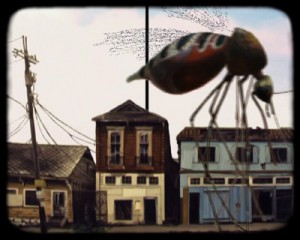 'Requiem', 2007: Sun Xun Animation A top hat, a solider, an airplane, a magician and a mosquito; these are the poignant and recurring images that might have been collected and stored in audience member’s memories after viewing Chinese artist Sun Xun’s work the opening night of the Cinema Pacific Film Festival last week here in Eugene, OR.
Cinema Pacific is a collaborative effort between the University of Oregon and the Eugene community in which director Richard Herskowitz works with graduate students in the UO Arts and Administration Program (including CV’s own Tomas Valladares and Nan Yang) alongside undergraduate interns to administer a five day festival of screenings, live multimedia performances and art exhibitions. This annual film festival is devoted to discovering and fostering the creativity of international films and new media from Pacific-bordering countries, including nations in America and Asia. Several guest artists and performers engage with audiences in post-film discussions to explore aesthetic and social issues, and developments in media production. This year’s festival focus was specifically emphasizing the commercial and independent film production from mainland China.
What is striking about Sun Xun’s work is the way he juxtapositions traditional techniques of hand-drawn animation with new media. In creating his detailed and meticulous animations, Sun Xun uses traditional calligraphy techniques to produce drawings on canvas, silk and printed materials. These are then hand-copied frame by frame to create flickering effects and complex, multilayered textures. When filming the drawings sequentially one at a time, Sun Xun creates a sense of movement that also indicates the passing of time, as well as the beauty of basic simple forms.
 'Shock of Time', 2006: Sun Xun Animation Sun Xun’s animations particularly focus on elements of world history and politics, as well as natural organisms (such as the incessant plaguing mosquito). When growing up in China, Sun Xun knew it while in a time of reinvention; his work reflects the time when China was shifting from socialism to capitalism, a time of economic reform and new trade policies. Living in a mining community at a young age, Sun Xun’s early memories are colored with images of loudspeakers booming propaganda messages every morning and uniformed workers shuffling against chimneys. This resulted in visual remnants of industrialization and other historical conceptualizations that ultimately planted the seeds for much of Sun Xun’s work
Though the overall issues surrounding Sun Xun’s politically charged art are complex, what resonates is a larger message: the power art possesses in mirroring a culture, a society and a country. From Sun Xun’s animated works, history is illuminated through art as it addresses the historical contexts of China through a multitude of drawings that incorporate text within the images. In this way, the stories of China are not forgotten, but preserved through his precise and authentic animations.
 'The New China', Sun Xun Animation For more information on Sun Xun and the Cinema Pacific Film Festival, please visit: http://cinemapacific.uoregon.edu/

“How long till we get there?”
“Just one more hour,” was always the guide’s response.
But just one more hour on a bus traveling on bumpy roads through winding hills turned into six more hours, and when the ChinaVine team arrived at the Jiuzhou Village in Guizhou Province the team was late, very late. The Miao people’s Sister Meal festival was over, and the intricate clothing the women had donned for the occasion was being removed. What the seven-member ChinaVine team, had hoped to capture in pictures and video had ended. But the residents of Jiuzhou Village forgave their Western guests. In an act of kindness, the women of the village put their festive clothing back on and re-performed many of the dances for their guests—even coxing ChinaVine’s three blonde-haired female members to join them in dance. As the sun set, the ChinaVine team was taken into a house where a large table had been covered in local delicacies. Each family in the village had made a special dish for this potluck dinner, and the ChinaVine members were the evening’s honored guests. Miao custom says a guest’s bowl should never go empty, which meant whenever a bowl was cleared of its contents, a Miao woman would come along and fill it again. There was also the rice wine, a whole bucket full, and according to Miao custom, the festivities couldn’t end until the bucket had been emptied, poured from seashells into the mouths of all those present. With their senses bombarded with food and drink, dancing and hospitality, the ChinaVine members said goodbye to their gracious hosts, and stumbled back onto the bus. “It was amazing,” says ChinaVine’s Tomas Valladares, “every sense was totally bombarded. It was just incredible.” This experience will remain Valladares’ most memorable from his three trips to China.
If ChinaVine has an unsung hero it is Tomas Valladares. The 26-year-old University of Oregon Arts and Administration master’s student has been working on the project since its foundation in 2006 and has been ChinaVine’s Project Manager since 2007. He has shot numerous photos and video and created a series of audio tracks for the project. He has worked with well over 50 people, on projects ranging from films to digital books. A self-described “media wrangler,” Valladares worked on both the original ChinaVine website as well as the new site—the latter commanding much of his present work. He also is currently working with the US Library of Congress to have ChinaVine’s 20,000 images and over 80 hours of video and audio files documented at the archive. But in June of this year, the graduate student will leave his four-year post at ChinaVine for good, handing over the reins to a successor. And he will be missed.
“Tomas Valladares” says ChinaVine cofounder, Doug Blandy “has brought to ChinaVine a passion for learning about China along with an ease of manner permitting him to fully engage in collaborating with our Chinese partners.” Blandy says Valladares’ knowledge of all things ChinaVine is immense and refers to the young man as “the project’s living interactive database.” And while Blandy says Valladares will be missed, he hopes to continue working with Valladares in whatever way he can.
[vimeo]http://vimeo.com/6612652[/vimeo]In 2006 Valladares was an undergraduate at the University of Central Florida. The native Floridian had created a short documentary about his Cuban heritage for a class taught by ChinaVine cofounder, Professor Kristin Congdon. The film impressed Congdon, and the professor asked Valladares to join FolkVine, a predecessor of the ChinaVine project. When she and Blandy created ChinaVine in 2006, she asked Valladares to join the team. The following year he was Project Manager. He would occupy this position for two years while at UCF, and would continue in this role when, in 2009, he started graduate school at the University of Oregon’s School of Architecture and Allied Arts.
Valladares says he’s not quite ready to give up the project he has labored on for the last five years. “But,” says Valladares, “I think I am ready to hand it off to the next person and go onto the next step.”
What his next step will be Valladares does not know. The graduate student is currently busy working on his thesis, organizing for the upcoming Cinema Pacific Film Festival, working on the e-portfolio project as a Graduate Research Fellow at the Center for Community Arts and Cultural Policy at the UO, and has been working with the Americans for the Arts Emerging Leader Program. He is also, at least for the time being, still ChinaVine’s Project Manager.
Looking back at his time on ChinaVine, Valladares say, “It’s been awesome to have been there from the beginning.”
 ChinaVine member Nan Yang at the opening ceremony of the 2008 Beijing Olympics. The most surprising thing for ChinaVine member Nan Yang was just how much she learned about her native China. A city girl, from the Chaoyang District of Beijing, Yang is currently leading ChinaVine’s efforts to create a presence on China’s three major social networks. Since December of 2011 she has been busy posting to Renren and Sina Microblog, and transferring video to Tudou. In the process, the 25-year-old has learned about many of the treasures her country holds outside Beijing.
Yang is currently studying Arts and Administration at the University of Oregon’s School of Architecture and Allied Arts. The master’s student joined the UO ChinaVine team this winter as the group’s social media liaison to China. Yang has set up ChinaVine accounts on Renren, China’s version of Facebook, Sina Microblog, similar to Twitter, as well as Tudou, a video-posting site similar to Vimeo or YouTube.
The Chinese government has banned Facebook, Twitter, Vimeo, and YouTube in China, blocking these sites from Chinese users behind a large firewall, sometimes called “The Great Firewall of China.” But for companies like Renren and Tudou—both of which began as small start-ups—not having competition from Facebook and Twitter has allowed them to corner the market on China’s social networks. According to FastCompany, Renren might even go public, with an initial public offering sometime this year.
Since the fall of 2010, ChinaVine has worked hard to create its presence on social media networks. While the group has connected with liked-minded individuals and organizations in the English-speaking world—as well as interested parties in Chinese cities like Beijing and Shanghai through Flickr, which is not banned in China—Facebook, Twitter, and Vimeo are inaccessible to users in China. Couple this with the language barrier and it’s easy to see the mostly English-speaking ChinaVine team had a problem: How to spread the message about the group in China? That’s when the ChinaVine team found Nan Yang.
It was orientation for new Arts and Administration students at the School of Architecture and Allied Arts, and long-time ChinaVine member Tomas Valladares, a second-year student in Arts and Administration, was mingling with the newcomers. That’s when he met Yang. “I instantly new she would be great to work with,” says Valladares. He told her about the program, and the following school quarter Yang was on the team.
“We now have a good presence on the Chinese social networks,” says Yang about her campaign. According to the social media liaison, ChineVine’s followers are growing steadily. Yang has also started receiving feedback from users interested in her Tudou posts. Yang says, informing the public and interacting with people like this has been very exciting.
What’s in the future of Nan Yang?
Yang says she plans on joining the ChinaVine field school this summer in her hometown, Beijing. In the meantime she will post updates, and transfer video from Vimeo to Todou, in the process learning more about her native country.
|
|




























